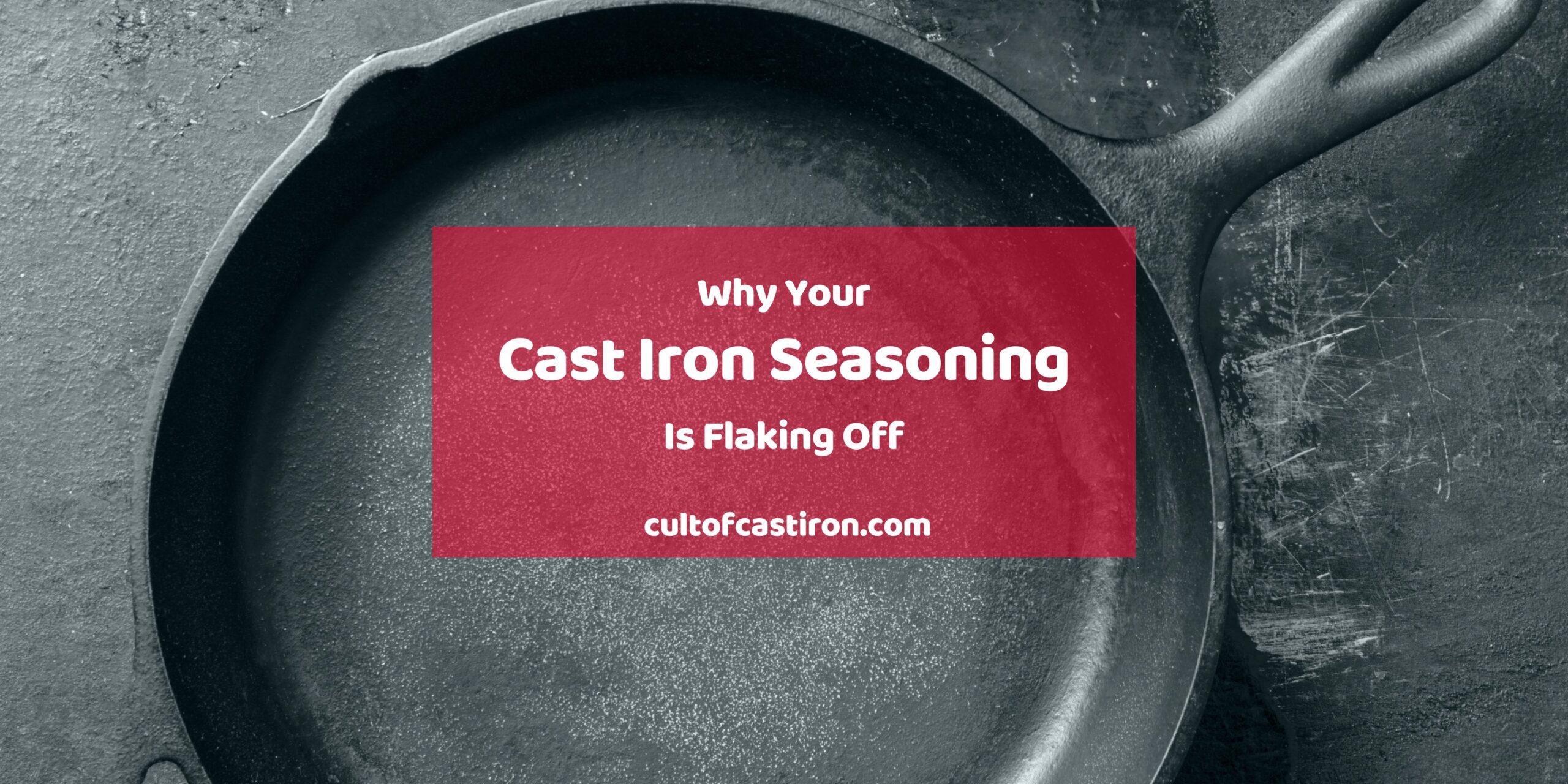Are you seeing some peculiar black specks on your food that have been cooked in your cast iron cookware? Don’t fret, that is just bits of the pan’s seasoning that are coming off the surface.
The primary reason why your cast iron seasoning is flaking off is because of improper seasoning – you may have put too much oil, or you’ve used the wrong type of oil. Also, the oil may not have reached the right temperature and thus it failed to bond with the metal. In other cases, too much poking and prodding with metal utensils or cooking with acidic foods can loosen bits of seasoning and impart them on your food. Whatever the case, this predicament can be easily reversed in a few simple steps.
Keep reading as we take a more in-depth look at why your cast iron seasoning is flaking off, and how you can prevent it from happening in the future.
5 Reasons Why Your Cast Iron Seasoning is Flaking Off (and 5 Solutions To Keep Them Doing So)
There are many reasons why your cast iron pan’s seasoning is flaking off. Try to retrace your steps to identify which of these reasons is the root cause of your problem.
1. You put in too much oil while oiling or seasoning
Putting in too much oil on a cast iron pan during the seasoning process or during regular oiling after use can result in your seasoning flaking off in the future. This is because excess oil typically forms a thick and uneven layer of seasoning that is susceptible to peeling at the slightest hint of abrasion.
The Solution: Use less oil after cleaning a dirty cast iron pan or when you’re putting on a fresh coat of seasoning. You should also wipe off any excess oil on your pan with a rag before seasoning or storage,
2. You used saturated fats for seasoning
Your oil of choice may have also been the factor that caused your seasoning to peel off. Let’s categorize these types of cooking oils into two broad groups: saturated fats and unsaturated fats.
Saturated fats like lard, butter, and coconut oil solidify when at room temperature. Meanwhile, unsaturated fats like olive oil, canola oil, and avocado oil remain in their liquid form even at room temperature.
Of these two, saturated fats are more likely to form weaker bonds as they are less reactive, which means they may be more prone to flaking than other types of oils.
Moreover, you might have applied the saturated fats on the pan while in their solid form. This can lead to a thick and uneven layer of seasoning forming, which leads to flaking as discussed in the previous section.
The Solution: The easiest thing to do here is to switch to unsaturated fats. With that said, saturated fats can still be used for seasoning.
To reduce the chances of seasoning from saturated fats from flaking, you should make sure to melt these fats first before application. Also, make sure to wipe off the excess oil before heating the pan to the oil’s smoke point.
3. You failed to reach the oil’s smoke point
Fat molecules are the building blocks needed to create a cast iron pan’s seasoning. However, they need to be treated with enough heat to kickstart the polymerization process. If the oil is subjected to an inappropriately low temperature, it will not properly bond with the pan and will cause flaking when used.
However, you must be careful with going past the smoke point of oils as this can result in you burning off your seasoning. Yes, burnt and ashy seasoning is not good for anyone.
The Solution: Apart from knowing the smoke point of your choice of oil, you must also make sure that your pan is being subjected to that temperature during seasoning. So whether you do the seasoning in an oven, grill, or on a stovetop, be sure to have a thermometer on hand to ensure that the right temperature is attained.
4. You scratched the seasoning with metal utensils
A cast iron pan’s seasoning is quite durable and resilient when properly bonded to the pan. However, harsh poking and prodding with metal utensils may scratch off some of the layer of seasoning on the pan. Moreover, that little scratch can induce further flaking if it is agitated further by something abrasive.
Apart from the annoying black specks of seasoning being imparted on your food, these scratches can be a conduit for moisture to find its way into the surface of the bare cast iron and induce rusting.
The Solution: Switch out your metal cooking utensils with silicone or wooden ones as they are less likely to scratch off your seasoning.
5. You cooked with acidic ingredients
Cooking acidic food in a cast iron pan can cause the seasoning of the pan to flake off. The acids in the food can break down the seasoning layer on the pan and cause flaking. You may even get a hint of metallic taste in your acidic food if it is cooked long enough on the pan.
The Solution: The simplest way to avoid this problem is by using your enameled cast iron cookware to cook acidic food. If you only have an unenameled cast iron pan in your kitchen, you can still cook acidic food on it, but make sure to properly clean and oil it afterwards to prevent rusting.
6. You’re cooking with a brand new cast iron pan
More often than not, brand new cast iron pans come “pre-seasoned”. That means that the company has already applied a layer of seasoning to protect the pan while on display and so that you can use it immediately after purchase.
However, this layer of seasoning is not yet established and tends to be thin, hence it is prone to flaking off when used for the first few times.
The Solution: While this is completely normal, you can apply an additional layer of seasoning or two before first use to prevent the factory seasoning from coming off. Some even choose to strip off the preseasoning and start from scratch.
When I first had my cast iron pan, the seasoning was flaking off as well. I just used it and used it and used it – the seasoning got better over time, but I did have to endure a few days of black specks on my food though.
What Happens If You Ingest Flaked-off Cast Iron Seasoning?
Thankfully, ingesting a few bits of flaked-off seasoning will not cause any severe health effects to people. Much of the fear regarding its safety stems from the notion that charred foods contain a carcinogenic chemical called acrylamide. While the link between acrylamide and cancer is still inconclusive at best, one thing is for sure: cooking oils do not naturally contain acrylamide, and hence the “burnt” layer of oil that is the seasoning does not contain carcinogenic compounds.
Besides that, the amount of flaked-off seasoning that you may be ingesting will be negligible. The best thing to do here is to season your cast iron cookware properly so that it won’t flake off in the first place.
How To Fix Your Cast Iron’s Seasoning If It’s Flaking Off
Restoring your cast iron pan’s sheen is relatively easy – it just needs some time and a lot off elbow grease. Here’s how to restore the pan’s seasoning when it starts to flake off.
1. Soak the pan with equal parts water and vinegar
Note: this is mostly done for severe cases; for minor peeling, skip to step #2
If you are experiencing a lot of flaking and peeling, I do not suggest applying a band aid solution of slapping on another layer of seasoning as this is not likely to bond with the metal anyway. It may be time to strip the pan bare and start the seasoning from scratch.
To do this, let the pan soak for a few hours or overnight in an equal part of water and vinegar to strip away the remaining seasoning layers on the pan.
2. Scour the surface with a steel wool
Next, lightly scour the surface of the pan to remove bits of seasoning that will flake off anyway. You can use a stiff brush or a steel wool. You can also use salt or a mixture of baking soda and water to create an abrasive paste that can remove as much of the weakly-bonded seasoning from the pan.. Continue scrubbing until you see the original dark gray color of bare cast iron.
3. Rinse and dry you pan
Once you have removed as much of the weakly-bonded seasoning as you can, rinse the pan with water and dry it thoroughly with a towel until all beads of water are absent on the surface. After that, place the pan on a burner for a few minutes to ensure that the pan is bone dry before applying a layer of seasoning.
4. Reseason your bare cast iron pan
Now that the pan is dry, it is now ready to be reseasoned! You can read out full seasoning guide here, but in summary:
Put a few drops of oil on the pan and rub it on every nook and cranny you can see. Make sure that there are no dull spots on the pan. Once you’ve applied the oil all over the pan, wipe away any excess oils using a towel or a rag, then heat it until you’ve reached the smoke point of the oil. Once the oil looks dry, the seasoning has set! Apply another layer of oil on the pan to keep it from rusting while in storage, and you’re done!
Wrapping Up
While fixing a peeling or flaking cast iron pan seasoning is not a hard endeavor, I think we can all agree that prevention is better than cure.
If you’re still hungry for more information on everything about cast iron cookware, then be sure to check out the rest of the Cult of Cast Iron blog!

Miguel is a cast iron enthusiast from Cavite, Philippines. He works in the digital marketing field as a content marketing strategist. On the side, he manages a small online bookstore and tends to his plants.

